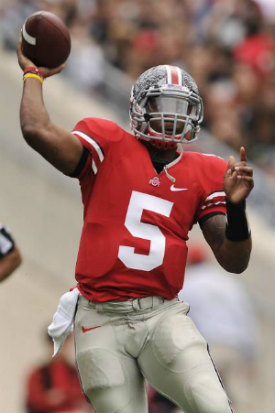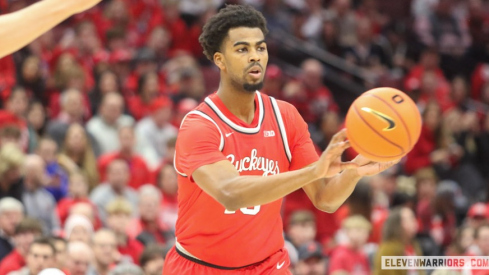"Defense and special teams - long snappers and punting - ball control and winning - these are a few of my favorite things."
 Responsible for keeping the offense running quickly
Responsible for keeping the offense running quicklyThis is not only a laundry list of things that Tressel might have drawn a heart around in his diary, but also the foundation of Urban's overall strategic approach to football.
As the official OSU website details:
One of only two active collegiate coaches with multiple BCS national championships and one of only 13 coaches in the last 50 years to win multiple national championships, Meyer's plan includes four tenets: play great defense; score in the red zone; dominate turnovers; and win the kicking game. His teams have succeeded in each of those competencies.
As Ivan Maisel described way back in 2003, "Tresselball depends on defense, regards field position as paramount and slowly, inevitably pressures the other team until it cracks."
For all the similarities, there are nonetheless differences in clock management and tempo. This year's incarnation of Urban's offense is different even than his past offenses, starting with the no-huddle.
Doug Lesmerises writes:
For instance, Meyer said he didn't want to go with an up-tempo offense at Florida because he wanted the leadership of Tebow and some of his veteran offensive linemen in the huddle.
"When you go up-tempo, you lose the leadership of the quarterback," Meyer said. "The whole intangible part of football, you lose that when you go fast, no-huddle. So I'm evaluating that now. I don't know."
However, Urban was convinced of the value of the no-huddle after visiting programs like Chip Kelly's Oregon offense over the year while working for ESPN. He then meshed his basic offensive tenets with those of his new offensive coordinator, Tom Herman.
"We want to be no-huddle, we want to be up-tempo and use that to our advantage. And we want to be balanced. We want to run the football first to set up the throwing game...I don't know if culture shock is the right word, but that's a major philosophical change that these kids need to understand and get used to," Herman said. "We could call the whole offense without saying a word if we wanted to in terms of the skill guys. It's our own sign language and the kids learn it and it doesn't change over their careers.
In truth, we are still likely to a see a huddle every now and then, depending on specific game situations. Braxton will have to look into his teammates' eyes and will them to convert 4th downs, just like Tebow before him.
The no-huddle (with a conservative bit of huddling thrown in) is a logical next step for Urban's brand of power-run spread offense, but one that has never been seen at any of his previous stops and certainly never before at Ohio State. Instead, we'll have to look at Tom Herman's Iowa State offenses to understand the next evolution in Urbanball.
Advantages of the No-Huddle
The no-huddle offense is spreading rapidly across all levels of football because it offers several advantages over traditional forms of clock management: 1. it limits defensive substitution and movement/disguises; 2. it allows for more reps and greater efficiency in practice; and 3. (what we'll mainly be concentrating on here) it allows for the offense to set a flexible tempo.
Chris Brown details the most common advantage of the no-huddle:
Modern defenses want to match offenses in terms of strength and speed via personnel substitutions. They also want to confuse offenses with movement and disguise. The up-tempo no-huddle stymies those defensive options. The defense doesn’t have time to substitute, and it’s also forced to show its hand: It can’t disguise or shift because the quarterback can snap the ball and take advantage of some obvious, structural weakness.
While Ross expounds upon the second advantage:
College teams have relatively little practice time. The no-huddle allows an offense to get far more repetitions. While in the past a team may run a play, then a coach would instruct one player with the ten other players standing around, no-huddle teams can repeatedly rep plays, with coaching corrections made when the second team takes its turn or in film study.
 A rare slower moment in camp
A rare slower moment in camp Related to the first advantage, the no-huddle also allows offenses to control the game's overall tempo. Ross writes that:
Coaches like Chip Kelly and Gus Malzahn's primary objective is to keep their offense relatively simple so that they can play at breakneck speed. Malzahn, for instance, wants his offense to run 80 plays per game. Their goal is to limit a defense's substitution, tire the on-field players, and eventually overwhelm the defense's capacity to adjust.
While Oregon runs the no-huddle at breakneck speed in order to have the highest number of offensive snaps per game possible, that doesn't have to be so.
Urban's offense will similarly strive for a higher number of snaps per game, but it will sometimes go to the line of scrimmage after a play in the no-huddle, then control the clock by letting the play clock wind down as necessary. In short, the no-huddle allows the offense to methodically control the clock and set the tempo for the defense but doesn't require scoring drives to only last 30 seconds.
what will it look like?
The most relevant quantitative metric of game tempo is the number of plays per game that an offense runs. As mentioned, Urban's previous offenses at Florida did not make extensive use of the no-huddle, but we can nonetheless provide some context using his previous offense, Herman's offenses at Iowa State, Oregon's offense, and Ohio State's Bollman-led squads:
| Year | Ohio State | Florida | Iowa St | Oregon |
|---|---|---|---|---|
| 2011 | 62 | 61 | 79 | 78 |
| 2010 | 69 | 68 | 69 | 79 |
| 2009 | 68 | 66 | 69 | 68 |
In all honesty, there aren't very significant differences in average number of plays run per game until last season, when both Iowa State and Oregon average roughly 16 (or 25%) more plays per game.
Herman's Iowa State offense really sped up the tempo last season relative to his first two years as offensive coordinator. I'd guess this year's offense doesn't quite make it to 79 plays per game, but should nonetheless exceed any average during the Bollman years.
However, the average number of plays per game doesn't take into account the time of possession. Many fans were concerned that the no-huddle offense would lower the offense's overall time of possession, limiting the defense's ability to rest between series.
We can get a sense for this by comparing the average time of possession with the average number of plays run per game. Unfortunately we don't have access to number of possessions per game data - measuring the average time per each offensive series would be the most ideal:
| Year | ohio State | Florida | Iowa St | Oregon |
|---|---|---|---|---|
| 2011 | 30:40 | 28:18 | 29:08 | 24:59 |
| 2010 | 32:10 | 28:36 | 28:33 | 27:54 |
| 2009 | 31:29 | 30:53 | 28:17 | 26:18 |
No huddle doesn't necessarily have to mean hurry up: while Oregon certainly has a lower average time of possession per game than any of the other three schools, the 2011 Iowa State offense was able to run an astounding number of plays per game while still maintaining a high average time of possession.
Furthermore, time of possession per game (again, this doesn't take into account the number of drives per game) isn't really correlated with winning at all. Commentators love to point out the average time of possession as an extremely important statistic, but only Ohio State averaged a greater time of possession than its opponents.
Even more telling is the fact that the 2011 Iowa State offense averaged ten more plays per game than the 2010 offense, yet increased its average time of possession by 30 seconds per game. This is partly because more plays mean more overall time to run those plays, but it's in stark contrast with the 2011 Oregon offense, which averaged about 4 minutes less than Iowa State.
John Reed, the author of Football Clock Management, has researched clock and ball control in the NFL and gotten it down to as much of a science as anyone studying the game. Reed's basic (and simple) philosophy is that "Teams that are ahead should play slower to run the clock down, while teams trailing should play faster to preserve time -- and increase their chances of coming back."
The 2012 Buckeyes' no-huddle will still allow for this sort of variable clock control while still controlling the pace for defenses. I expect the 2012 offense to average somewhere around 70 plays per game while maintaining a similar time of possession.



